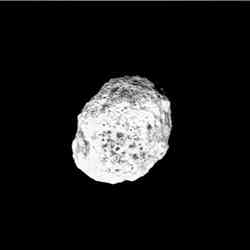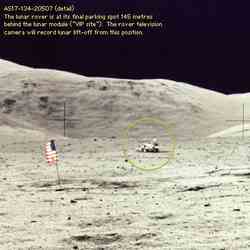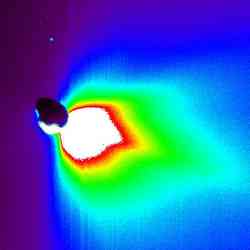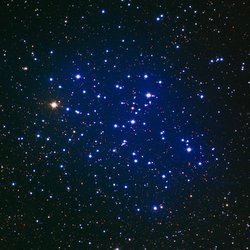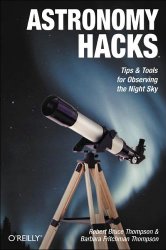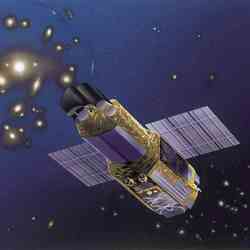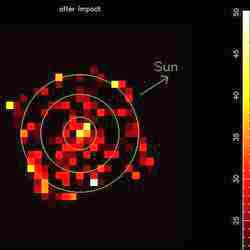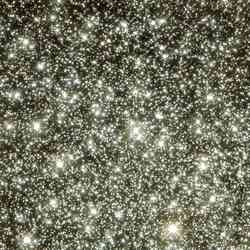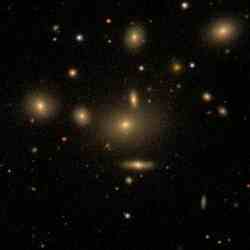
NGC 5919 is a member of a galaxy cluster Abel 2063. Image credit: SDSS. Click to enlarge.
Dr. Richard Kron, director of the Sloan Digital Sky Survey, announced a new undertaking that will complete the largest survey of the universe. This survey will add new partners and undertake new research missions, and will run through summer 2008.
Late last month the funding package for a new, three-year venture called the Sloan Digital Sky Survey II (SDSS-II) was completed, led by the Alfred P. Sloan Foundation of New York City, the National Science Foundation (NSF), the U.S. Department of Energy and the member institutions.
The SDSS has been carrying out a massive survey of the sky using a dedicated 2.5-m telescope at Apache Point Observatory near Sunspot, New Mexico. SDSS-II will complete observations of a huge contiguous region of the Northern skies and will study the structure and origins of the Milky Way Galaxy and the nature of dark energy.
The Sloan Digital Sky Survey is the most ambitious astronomical survey project ever undertaken, already having measured precise brightnesses and positions for hundreds of millions of galaxies, stars and quasars during the last five years. The consortium of more than 300 scientists and engineers at 23 institutions around the world — and hundreds of other scientists working in collaboration — are using these data to address fascinating and fundamental questions about the universe.
The exciting results from the SDSS data to date include the discovery of distant quasars seen when the universe was just 900 million years old; the definitive measurement of the large-scale distribution of galaxies, confirming the role of gravity in growing structures in the universe; and evidence that the Milky Way Galaxy grew by cannibalizing smaller companion galaxies.
“We are very excited with the funding agencies’ decision to support this important mission,” said Kron of the University of Chicago. “The dedicated scientists and engineers of the Sloan Digital Sky Survey have worked tirelessly to open new ways of seeing the Universe.
“We believe the SDSS II discoveries that lie ahead will further scientific discoveries and lay the groundwork for future astronomical exploration. We are sure that the data released to the public will yield discoveries for years to come.”
In the last five years, the SDSS has released data for almost 200 million objects to the public. These data have been used by hundreds of researchers around the world for scientific projects ranging from studies of nearby stars to explorations of the nature of galaxies.
“We are proud of the landmark contributions made by the Sloan Digital Sky Survey to our understanding of the evolution and structure of the universe and enthusiastically support this next phase of research,” said Doron Weber, program director of the Alfred P. Sloan Foundation. “The findings of the Sloan Digital Sky Survey have already produced the most accurate picture of the skies that has ever existed and we expect new discoveries that will continue to transform our knowledge of the universe.”
Eileen D. Friel, Executive Officer of the Division of Astronomical Sciences at the National Science Foundation, said the Sloan Digital Sky Survey “has enabled a remarkable array of scientific results, sometimes in unexpected areas. The completion of the original survey and its extension to address issues in galactic and stellar astronomy promises to strengthen the legacy of the survey and to make it an even more valuable resource for astronomers and educators.”
And Robin Staffin, Associate Director of Science for High Energy Physics in the Department of Energy’s Office of Science, said the agency was “delighted to see the Sloan Digital Sky Survey entering this new phase. SDSS has already contributed a great deal to our understanding of the fundamental structure of the universe, and has helped pioneer the connections between particle physics and cosmology. We expect that great science will come out of SDSS-II over the next few years.”
With the formation of SDSS-II, eight new institutions join the collaboration: American Museum of Natural History in New York City, the University of Basel (Switzerland), Cambridge University (UK), Case Western Reserve University in Cleveland, Ohio, the Joint Institute for Nuclear Astrophysics (University of Notre Dame, Michigan State University, and The University of Chicago), The Kavli Institute for Particle Astrophysics and Cosmology at Stanford, Ohio State University, and the Astrophysical Institute Potsdam (Germany). (A complete list of SDSS-I and SDSS-II partners can be found below).
SDSS-II has three components. The first, called LEGACY, will complete the SDSS survey of the extragalactic universe, obtaining images and distances of nearly a million galaxies and quasars over a continuous swath of sky in the Northern Hemisphere.
The new funding also inaugurates the second part of SDSS-II, the Sloan Extension for Galactic Understanding and Exploration (SEGUE), mapping the structure and stellar makeup of the Milky Way Galaxy, and gathering data on how the Milky Way formed and evolved.
“The SEGUE project will allow us for the first time to get a ‘big picture’ of the structure of our own Milky Way,” explained consortium member Heidi Newberg of Rensselaer Polytechnic Institute. “The mapping of the Milky Way is more than an exercise in cartography. Ages, chemical compositions, and space distribution of stars are major clues to understanding how our own Galaxy formed, and, by example, how galaxies, in general. formed.
“Identifying the oldest stars will help us understand how the elements of the periodic table were formed long ago inside of stars,” Newberg said.
The final piece of SDSS-II includes an intensive study of supernovae, sweeping the sky to find these remnants of gigantic explosions from dying stars. Astronomers can precisely measure the distances of distant supernovae, using them to map the rate of expansion of the universe.
“This study will help to verify and quantify one of the most important discoveries of modern science – the existence of the cosmological dark energy,” explained consortium member Andy Becker of the University of Washington.
Becker explained that the SDSS telescope is uniquely positioned to both discover, and follow up on, a wealth of supernovae at distances at which other surveys have found very few objects. This allows a direct measurement of the effects of dark energy on the geometry of the universe as a whole.
Original Source: SDSS News Release

